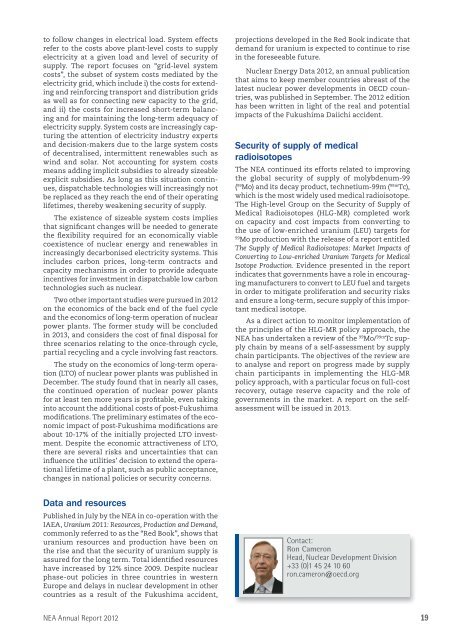Download the report in pdf format - OECD Nuclear Energy Agency
Download the report in pdf format - OECD Nuclear Energy Agency
Download the report in pdf format - OECD Nuclear Energy Agency
You also want an ePaper? Increase the reach of your titles
YUMPU automatically turns print PDFs into web optimized ePapers that Google loves.
to follow changes <strong>in</strong> electrical load. System effects<br />
refer to <strong>the</strong> costs above plant-level costs to supply<br />
electricity at a given load and level of security of<br />
supply. The <strong>report</strong> focuses on “grid-level system<br />
costs”, <strong>the</strong> subset of system costs mediated by <strong>the</strong><br />
electricity grid, which <strong>in</strong>clude i) <strong>the</strong> costs for extend<strong>in</strong>g<br />
and re<strong>in</strong>forc<strong>in</strong>g transport and distribution grids<br />
as well as for connect<strong>in</strong>g new capacity to <strong>the</strong> grid,<br />
and ii) <strong>the</strong> costs for <strong>in</strong>creased short-term balanc<strong>in</strong>g<br />
and for ma<strong>in</strong>ta<strong>in</strong><strong>in</strong>g <strong>the</strong> long-term adequacy of<br />
electricity supply. System costs are <strong>in</strong>creas<strong>in</strong>gly captur<strong>in</strong>g<br />
<strong>the</strong> attention of electricity <strong>in</strong>dustry experts<br />
and decision-makers due to <strong>the</strong> large system costs<br />
of decentralised, <strong>in</strong>termittent renewables such as<br />
w<strong>in</strong>d and solar. Not account<strong>in</strong>g for system costs<br />
means add<strong>in</strong>g implicit subsidies to already sizeable<br />
explicit subsidies. As long as this situation cont<strong>in</strong>ues,<br />
dispatchable technologies will <strong>in</strong>creas<strong>in</strong>gly not<br />
be replaced as <strong>the</strong>y reach <strong>the</strong> end of <strong>the</strong>ir operat<strong>in</strong>g<br />
lifetimes, <strong>the</strong>reby weaken<strong>in</strong>g security of supply.<br />
The existence of sizeable system costs implies<br />
that significant changes will be needed to generate<br />
<strong>the</strong> flexibility required for an economically viable<br />
coexistence of nuclear energy and renewables <strong>in</strong><br />
<strong>in</strong>creas<strong>in</strong>gly decarbonised electricity systems. This<br />
<strong>in</strong>cludes carbon prices, long-term contracts and<br />
capacity mechanisms <strong>in</strong> order to provide adequate<br />
<strong>in</strong>centives for <strong>in</strong>vestment <strong>in</strong> dispatchable low carbon<br />
technologies such as nuclear.<br />
Two o<strong>the</strong>r important studies were pursued <strong>in</strong> 2012<br />
on <strong>the</strong> economics of <strong>the</strong> back end of <strong>the</strong> fuel cycle<br />
and <strong>the</strong> economics of long-term operation of nuclear<br />
power plants. The former study will be concluded<br />
<strong>in</strong> 2013, and considers <strong>the</strong> cost of f<strong>in</strong>al disposal for<br />
three scenarios relat<strong>in</strong>g to <strong>the</strong> once-through cycle,<br />
partial recycl<strong>in</strong>g and a cycle <strong>in</strong>volv<strong>in</strong>g fast reactors.<br />
The study on <strong>the</strong> economics of long-term operation<br />
(LTO) of nuclear power plants was published <strong>in</strong><br />
December. The study found that <strong>in</strong> nearly all cases,<br />
<strong>the</strong> cont<strong>in</strong>ued operation of nuclear power plants<br />
for at least ten more years is profitable, even tak<strong>in</strong>g<br />
<strong>in</strong>to account <strong>the</strong> additional costs of post-Fukushima<br />
modifications. The prelim<strong>in</strong>ary estimates of <strong>the</strong> economic<br />
impact of post-Fukushima modifications are<br />
about 10‐17% of <strong>the</strong> <strong>in</strong>itially projected LTO <strong>in</strong>vestment.<br />
Despite <strong>the</strong> economic attractiveness of LTO,<br />
<strong>the</strong>re are several risks and uncerta<strong>in</strong>ties that can<br />
<strong>in</strong>fluence <strong>the</strong> utilities’ decision to extend <strong>the</strong> operational<br />
lifetime of a plant, such as public acceptance,<br />
changes <strong>in</strong> national policies or security concerns.<br />
projections developed <strong>in</strong> <strong>the</strong> Red Book <strong>in</strong>dicate that<br />
demand for uranium is expected to cont<strong>in</strong>ue to rise<br />
<strong>in</strong> <strong>the</strong> foreseeable future.<br />
<strong>Nuclear</strong> <strong>Energy</strong> Data 2012, an annual publication<br />
that aims to keep member countries abreast of <strong>the</strong><br />
latest nuclear power developments <strong>in</strong> <strong>OECD</strong> countries,<br />
was published <strong>in</strong> September. The 2012 edition<br />
has been written <strong>in</strong> light of <strong>the</strong> real and potential<br />
impacts of <strong>the</strong> Fukushima Daiichi accident.<br />
Security of supply of medical<br />
radioisotopes<br />
The NEA cont<strong>in</strong>ued its efforts related to improv<strong>in</strong>g<br />
<strong>the</strong> global security of supply of molybdenum-99<br />
( 99 Mo) and its decay product, technetium-99m ( 99m Tc),<br />
which is <strong>the</strong> most widely used medical radioisotope.<br />
The High-level Group on <strong>the</strong> Security of Supply of<br />
Medical Radioisotopes (HLG-MR) completed work<br />
on capacity and cost impacts from convert<strong>in</strong>g to<br />
<strong>the</strong> use of low-enriched uranium (LEU) targets for<br />
99<br />
Mo production with <strong>the</strong> release of a <strong>report</strong> entitled<br />
The Supply of Medical Radioisotopes: Market Impacts of<br />
Convert<strong>in</strong>g to Low-enriched Uranium Targets for Medical<br />
Isotope Production. Evidence presented <strong>in</strong> <strong>the</strong> <strong>report</strong><br />
<strong>in</strong>dicates that governments have a role <strong>in</strong> encourag<strong>in</strong>g<br />
manufacturers to convert to LEU fuel and targets<br />
<strong>in</strong> order to mitigate proliferation and security risks<br />
and ensure a long-term, secure supply of this important<br />
medical isotope.<br />
As a direct action to monitor implementation of<br />
<strong>the</strong> pr<strong>in</strong>ciples of <strong>the</strong> HLG-MR policy approach, <strong>the</strong><br />
NEA has undertaken a review of <strong>the</strong> 99 Mo/ 99m Tc supply<br />
cha<strong>in</strong> by means of a self-assessment by supply<br />
cha<strong>in</strong> participants. The objectives of <strong>the</strong> review are<br />
to analyse and <strong>report</strong> on progress made by supply<br />
cha<strong>in</strong> participants <strong>in</strong> implement<strong>in</strong>g <strong>the</strong> HLG-MR<br />
policy approach, with a particular focus on full-cost<br />
recovery, outage reserve capacity and <strong>the</strong> role of<br />
governments <strong>in</strong> <strong>the</strong> market. A <strong>report</strong> on <strong>the</strong> selfassessment<br />
will be issued <strong>in</strong> 2013.<br />
Data and resources<br />
Published <strong>in</strong> July by <strong>the</strong> NEA <strong>in</strong> co-operation with <strong>the</strong><br />
IAEA, Uranium 2011: Resources, Production and Demand,<br />
commonly referred to as <strong>the</strong> “Red Book”, shows that<br />
uranium resources and production have been on<br />
<strong>the</strong> rise and that <strong>the</strong> security of uranium supply is<br />
assured for <strong>the</strong> long term. Total identified resources<br />
have <strong>in</strong>creased by 12% s<strong>in</strong>ce 2009. Despite nuclear<br />
phase-out policies <strong>in</strong> three countries <strong>in</strong> western<br />
Europe and delays <strong>in</strong> nuclear development <strong>in</strong> o<strong>the</strong>r<br />
countries as a result of <strong>the</strong> Fukushima accident,<br />
Contact:<br />
Ron Cameron<br />
Head, <strong>Nuclear</strong> Development Division<br />
+33 (0)1 45 24 10 60<br />
ron.cameron@oecd.org<br />
NEA Annual Report 2012<br />
19
















